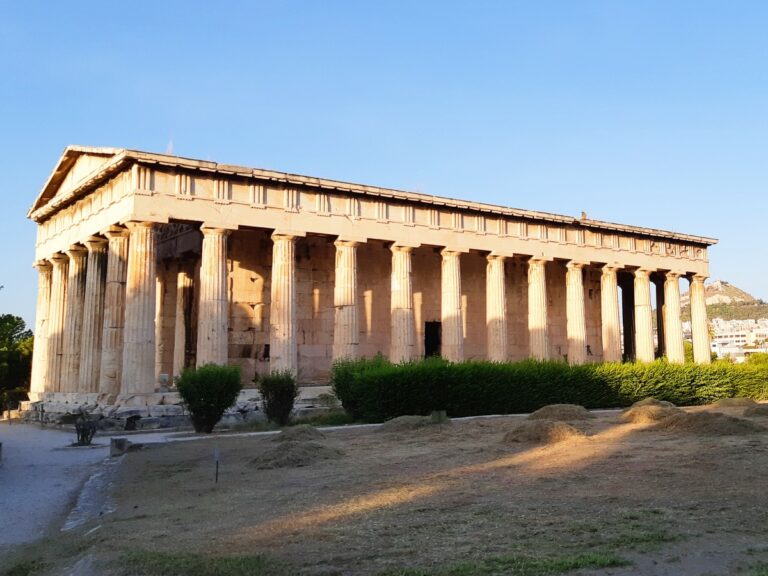The Agora is the one historical site in Athens that most clearly establishes the city’s position as the birthplace of Western civilization. Democracy in classical Greece was born in this context. The greatest Greeks, including Plato, Socrates, Demosthenes, and others, theorized, spoke out, and engaged in debate in this center of commerce, politics, religion, and culture. The Agora Museum, housed in the two-story Stoa of Attalos that was constructed in the second century BC, also houses the important artifacts.
The old Agora of Athens, also known as the Classical Agora, is the most well-known illustration of an ancient Greek agora. It is situated to the northwest of the Acropolis and is bordered on the south by the Areopagus Hill and on the west by the Agoraios Kolonos Hill, also known as Market Hill. The Agora’s original purpose was as a center of commerce, assembly, or habitation. Ths blog post gives a thorough guide to visiting the ancient Agora of Athens, what to expect when you get there and how to get there. So keep reading as we explore the ancient Agora of Athens together!
The Ancient Agora’s location predates the existence of Athens itself. It was formerly utilized as a cemetery and residential neighborhood. It became a public area and was used for gatherings and assemblies during the beginning of the 6th century BC.
Agora continued to advance during the Hellenistic and Roman eras, but the Heruli, a North European tribe, invaded Athens in 267 AD, and like all other places, the Agora was largely damaged and abandoned. During the era of classical Athens, the site attained its pinnacle. Civic offices and public buildings were built in great quantities. They were temples honoring the twelve Olympus gods as well as the spectacular Hephaestus temple. It now houses the excellent Agora Museum.
The Ancient Agora is a 15-minute walk from the Acropolis and near to the Thisseio and Monastiraki metro stations. Adrianou Street is where you enter. Tickets to the Ancient Agora and the Museum are 10 (April to October) or 5 (the rest of the year) (November – March). Seasonal changes in opening hours can be found on the official website. The Agora, the Acropolis, and five additional archaeological sites are all accessible to visitors in Athens.
The on-site ticket office sells tickets, or you can purchase them online: etickets.tap.gr.
The Athenian Agora’s entrance is free on certain days: Melina Mercouri, a former minister of culture, was remembered on March 6; International Day for Monuments and Sites / World Heritage Day is on April 18; World Museums Day is on May 18; European Heritage Days are the last weekend in September; The public holiday on October 28th is called “OXI day.”; And lastly, every month’s first Sunday, from November to March (2021 only) the 21sts of October, November, and December
The Ancient Agora is easily accessible from any part of Athens. The Ancient Agora can be readily accessible on foot from Monastiraki metro station in less than 5 minutes due to its central location in Athens. also Thissio on line 1 and “Monastiraki” on lines 1 & 3 are the nearest metro stations. Keep in mind that it takes 3–5 minutes to walk from the subway to the Ancient Agora.
It is essential to note that political, social, religious, and commercial activity are all centered around the ancient Agora in Athens. The Agora is the one historical site in Athens that most clearly establishes the city’s position as the birthplace of Western civilization. Democracy in classical Greece was born in this context.
The greatest Greeks, including Plato, Socrates, Demosthenes, and others, theorized, spoke out, and engaged in debate in this center of commerce, politics, religion, and culture. You can also visit the temples, a former concert venue, and consider life in the past beneath the renowned long, marble colonnaded arcades.
The Agora Museum, housed in the two-story Stoa of Attalos that was constructed in the second century BC, also houses the important artifacts. Agora’s shady lanes offer a wealth of things to explore. The Stoa of Attalos, one of Ancient Agora’s most spectacular structures, has undergone renovations and now houses the museum. The Temple of Hephaestus is another important landmark.
The Acropolis, which rises directly above you, will be perfectly visible while you are walking across the gardens. It is amazing to see how the ancient Greeks viewed this as the location of the gods, prosperity, and authority. Also some of Athens’ most significant structures, including the Apollon Patroos, the Church of the Holy Apostles, the Temple of Hephaistos, and others, can be found in the region of the old Agora. Some of the must-see places within the site at Agora include:
- Stoa of Attalos and the Temple of Hephaestus: one of the best preserved temples of its kind in Greece is the temple to Hephaestus. Hephaistos, the patron god of metalwork, pottery, and crafts in general, was honored by the temple’s construction. King Otto, the first monarch of the modern Greek state, was greeted with it. Since then, and up until the 1930s, the structure served as a museum.
- Holy Apostles Church of Byzantium: apart from the Temple of Hephaestus, the Church of Holy Apostles is the only building in the Ancient Agora that has survived entirely from its construction. It was built in the 11th century.
- Theater of Dionysus: the theater of Dionysus was built in honor of the Greek drama deity Dionysus and was one of the first and largest theaters in existence. It was situated south of the Acropolis. In the theater, significant Greek plays from the time were presented. The Dionysus Theatre has remained true to itself over the years.
- The Bouleuterion’s ruins: the Bouleuterion, a modest building from the end of the 6th century BC that resembles an early Greek temple, is located on the west side of the Athenian Agora. The area was used to accommodate the Boule council members, who were charged with Athenian Democracy’s legislative, executive, and advising functions.
- Atrium of Agrippa: this was given the name Agrippine in honor of their son-in-law and Augustus’ general, Marcus Vipsianus Agrippa. Around a marble-paved orchestra, the room could hold up to 1000 people at once, who would be seated across 19 rows of benches. Despite collapsing, the Odeon was restored, although with a smaller seating capacity than before—only 500 people.
- Urania’s Aphrodite Temple: the temple was entirely devoted to the Greek goddess Aphrodite and was located northwest of the Ancient Agora of Athens. Aphrodite’s sobriquet, Urania, denoted her lofty and spiritual nature. According to legend, the shrine houses a marble figure of the god created by the Greek sculptor Phidias.
The sacred Athens ruins welcome almost 3 million visitors each year. As a result, getting tickets at the counter is challenging. Nonetheless, you can go to the ticket office and buy the tickets if you want to try your luck. With proper identification, free tickets will be given to Europeans and children under the age of five.
There is no other sure-fire method if you happen to be there on a very busy day besides the www.headout.com, which can be bought online. You can also benefit from discounts and cashback when you book them online, which can save you time and money. There are different types of tours available and their cost available on their website.
In summary of today’s blog post on the guide to visiting the Ancient Agora of Athens, we talked about the Ancient Agora of Athens. We also explained that the word “agora” in Greek refers to a gathering place or marketplace. As implied by the name, it had truly been a marketplace for ages, where people came to buy and sell products.
We talked about how to access the city and what to expect, stating that the ancient Agora was not only utilized as a marketplace where people exchanged things, but it was also a meeting place where people discussed current events, gossip, and even attacked the government. Aristotle, Plato, and other well-known Greek philosophers congregated here to discuss and trade ideas.
It is highly recommended that you note that there are steps to climb while visiting, it is highly recommended that visitors go to Ancient Agora wearing comfortable shoes. Also early morning hours are the ideal time to visit the Agora. And note that for children under the age of five are admitted free of charge, and children from 6 to 24 are admitted for half price. Please be aware that a passport or photo ID is necessary for free or discounted tickets.
This concludes our discussion on the ultimate guide to visiting the Ancient Agora of Athens. Have you been to this city? Post your stories and advice in the comments section below!

